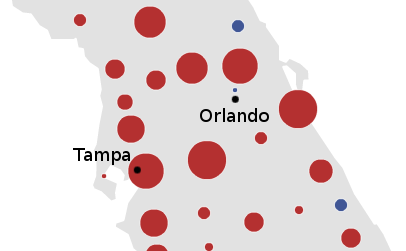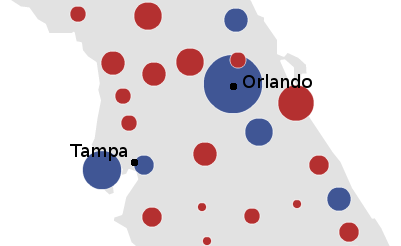The primary goals of any partisan redistricting should be to, first, protect endangered incumbents; and, secondly, maximize your seats without spreading your votes too thin to risk losing seats in a wave election. Of the Republican gerrymanders after 2000, the Michigan map (where the GOP legislature aimed for a 9-6 split) held up much better than Pennsylvania.
My map aims for a 13-5 split in normal years, and possibly a 14-4 split. It shores up Bean, Foster, and Halverson. It throws Mark Kirk and Jan Schakowsky together in the new CD-1, which Schakowsky would easily prevail; and Peter Roskam and Judy Biggert together in the new CD-11, which is designed to elect a Republican. It creates a new district centered in northern Chicago and the northwest Cook suburbs that are heavily trending Democratic. Lastly, Downstate it puts Aaron Schock’s congressional career in jeopardy by combining Peoria with Decatur, Champlain, and Bloomington while trading Republican farm territory with Shimkus and Johnson.
Oh, and one more thing, I renumbered all the districts in logical order – it doesn’t make much sense to me that Jerry Costello’s current district is the #12 while #1-11 and the 13th are all in Chicago or Suburban Chicago.
CD-1 (Schakowsky vs. Kirk) – Dem favored (57% white, 13% black, 7% asian, 19% hispanic)
Schakowksy’s currently configured #9, along with Quigley’s #5 are both too packed with Democrats. Instead of having a PVI of D+20 and D+19 respectively, it is possible I believe to create four Chicago-North districts with only slightly lesser Dem PVIs. This district extends along Lake Chicago from the lakefront wards of Chicago, north through Evanston, and New Trier Township, and then Lake County up to the Wisconsin border including Waukegan and Lake Zion.
CD-2 (Bean) (69% white, 3% black, 12% asian, 13% hispanic)
By moving Schakowsky’s district north, I was able to draw Bean much closer into Chicago and into Chicago-trending suburbs. Includes about 100k of Chicago itself, plus all of Niles, Northfield, and Palatine townships in Cook, plus more rural parts of Lake County. Should be significantly more Democratic now.
CD-3 (Vacant) (69% white, 1% black, 11% asian, 16% hispanic
The third and fourth districts break up Quigley’s district into two parts and marry those parts with suburban townships in Cook and northern DuPage which are trending Democratic. This district includes Elk Grove, Wheeling, and Maine townships, plus a fair amount of northern Chicago. It should elect a Democrat.
CD-4 (Quigley) (65% white, 4% black, 9% asian, 19% hispanic)
Combines Democratic leaning northern DuPage townships (Bloomington and Addison, which both voted for John Kerry) and a small part of Milton with the rest of Quigley’s current district left over from drawing the third.
CD-5 (Davis) (52% black)
I decide to reorient how the Hispanic-majority district is hooked up to the Chicago lakefront instead of the Cook County border in order to dilute some suburban Republican votes. Parts of Milton and all of York township in DuPage is added to the current district.
CD-6 (Gutierrez) (71% hispanic)
Little changes except how the two parts of the district are hooked up. They now make a backwards C. Still hideously gerrymandered. By the time the next census comes around, it should become possible to create two separate Hispanic-majority districts in Chicago.
CD-7 (Lipinski) (63% white, 5% black, 1% asian, 28% hispanic)
Firmly anchored in Cook County and adds several left-over Hispanic precincts in the current #4 to bolster the Democratic nature of the district. Possibly, Lipinski can be primaried if he still votes the way he does?
CD-8 (Rush) (52% black)
Extends out to Will County now to pick up Republican precincts in Lockport and Homer townships, same thing in Cook County (all of Lemont and Orland, most of Palos, and parts of Bremen and Worth, plus the south side of Chicago = a very good way to get rid of Republican precincts.
CD-9 (Jackson, Jr.) (52% black)
Adds parts of Will County (New Lenox, Manhattan, Frankfort and Green Garden townships) to currently existing district. Exchanges parts of Monee Township with Halvorson to increase her district’s Democratic performance.
CD-10 (Halvorson) (58% white, 12% black, 3% asian, 23% hispanic)
Includes left-over parts of Will County not in CD-8 or 9 (which are significantly more Democratic) with Democratic-leaning Aurora and a tiny part of Kendall County to connect the two. Should be safely Democratic now.
CD-11 (Roskam vs. Biggert) (71% white, 4% black, 9% asian, 13% hispanic)
Although it probably is possible to create several thin strands and eliminate every one of the remaining Chicago-area Republicans, it is safer I believe to leave one Republican-leaning district left. The CD-11 is designed to be such a district. It includes the left-over parts of DuPage not in the 4th or the 5th (Downers Grove, Lisle, Naperville, Winfield, Wayne, and parts of Milton (Wheaton) to include Roskam’s home), St. Charles and Dundee in Kane County, and Hanover and Barrington townships in Cook.
CD-12 (Foster) (74% white, 6% black, 2% asian, 14% hispanic)
All of LaSalle and DeKalb counties, most of Kane and Kendall, plus Rockford. Should be safer for a Democrat now.
CD-13 (Manzullo)
One of three districts that pack Republican voters to ensure the election or reelection of Democrats in neighboring districts. Rockford has been removed from the current district in exchange for all of McHenry and the far western rural townships of Lake. District also now drops down to include Republican Lee and most of Bureau counties.
CD-14 (Hare)
Cleaned up the lines significantly by removing snake that went all the way to to Decatur. District now includes all of Springfield and a few small rural counties to its north, along with some rural townships near Peoria. Should still be safe for Hare or any generic Democrat with the dominance of Springfield and Rock Island.
CD-15 (Schock) (80% white, 10% black, 3% asian, 2% hispanic)
By straightening out the lines of Hare’s district, and with some clever trading of territory with Johnson, it opens the possibility to end Schock’s career before the Republicans groom him to take a leadership role. Combines Peoria with Bloomington-Normal, Urbana-Champlain, and Decatur. Furthermore, it does it in a way that doesn’t lead to serpentine appendages going everywhere.
CD-16 (Johnson)
The consequence of going after Schock means that Johnson gets quite possibly the most Republican district in Illinois. Swaps Democratic-leaning Champlain and Urbana for Republican farm counties.
CD-17 (Shimkus)
The third and final district that packs Republicans. It would have been nice to go after Shimkus too, and indeed, it would probably not be too difficult to draw Shimkus into a Madison-Springfield, Macoupin centered district that would be very tough for him to win re-election in. But, many southern Illinois counties outside of Carbondale, Cairo, and Metro-East are trending very Republican and need to be placed somewhere.
CD-18 (Costello)
Adds Democratic-leaning Jersey, Calhoun, Macoupin, and most of Montgomery counties, Edwardsville of Madison country, to the currently Democratic areas of the district; swaps Republican-leaning Williamson, Franklin, and most of Union counties over to Shimkus’s district.


